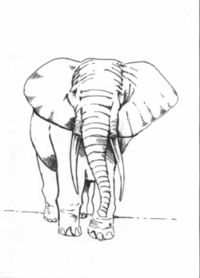Ljunfant Elephant
Hemm 2 verżjonijiet ta' dan is-sinjal. Agħfas il-buttuni hawn taħt biex tara l-istampi, il-kitba u l-vidjows.
There are 2 versions of this sign. Use the butttons below to view the photographs, signwriting and videos.
Is-sinjal għal LJUNFANT isir billi l-id tieħu l-forma ta’ Ċ. L-id tibda timxi mill-imnieħer, bil-pala ta’ l-id tħares laġenba. Tkompli timxi ’l fuq, imbagħad, l-id tinżel ’l isfel u ddur ’il barra bil-pala ta’ l-id tħares lejn l-art u bid-driegħ orizzontali. Fl-aħħar, id-driegħ jitla’ f’pozizzjoni vertikali waqt li l-id iżżomm l-istess forma imma tinqaleb lura laġenba lejn il-wiċċ bil-pala tħares ‘il fuq. Dan il-moviment jindika l-kurva tat-tromba tal-iljunfant.
It-tieni sinjal iktar sempliċi u inqas ikoniku. Jibda mill-imnieħer u jagħmel nofs ċirku kbir ’l isfel imbagħad lura ’l fuq.
Għal iljunfant żgħir jew kbir, is-sinjali jsiru minn id waħda bil-forma ta’ 5 bil-pala ‘l isfel. Id-distanza bejn l-art u l-id tindika d-daqs ta’ l-iljunfant. Is-sinjali għal ŻGĦIR u għal KBIR jiġu wara s-sinjal għal ILJUNFANT.
Is-sinjal għal ĦAFNA jiġi wara s-sinjal ta’ ILJUNFANT għaIl-plural. Ġieli tintuża id waħda jew iż-żewġ idejn forma ta’ 5 mgħawweġ bħala classifier. L-idejn jitpoġġew f’diversi postijiet fiż-żona tas-sinjali qisu hemmhekk qed jitqiegħdu ħafna iljunfanti.
Meta n-nom ILJUNFANT ikun is-suġġett ta’ verb ta’ moviment, l-idejn forma ta’ 5 mgħawweġ, jintużaw bħala classifiers u jimxu skond l-azzjoni.
The sign for ELEPHANT is made with one hand in the shape of Ċ. The hand starts moving from in front of the nose with the palm facing sideways and moving upwards. Next, the hand moves down and rotates out with palm facing the ground and the arm lying horizontally. Finally, the arm is lifted up in vertical position with the hand in the same shape as before but turned back and sideways towards the face, palm facing upwards. This movement represents the curved trunk of the elephant.
The second sign is simpler but less iconic since the large movement is made down from the nose forming a large curve back up.
To refer to a small or large elephant, one hand takes the shape of 5, palm down. The distance between the ground and the hand indicates the relative size of the elephant. The signs for SMALL or BIG are used after the sign for ELEPHANT.
The sign for MANY is used after the sign for ELEPHANT to express the plural. One or both hands in the shape of curved 5 are sometimes used as a classifier. The hands are placed in various places in the signing space as though placing several elephants there.
When the noun for ELEPHANT is the subject of a verb of movement the hands in the shape of curved 5 are used as classifiers, moving according to the action indicated by the verb.




